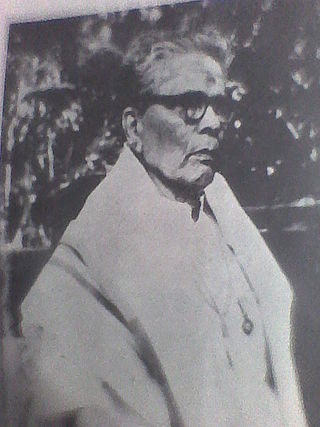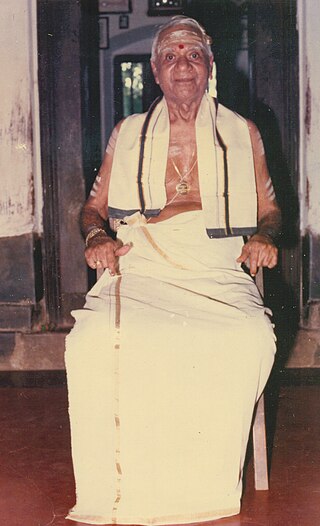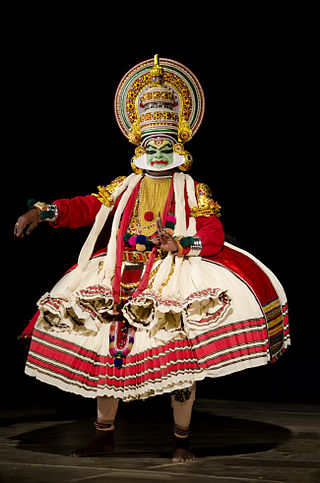Related Research Articles
Perumanoor Gopinathan Pillai, more popularly known as Guru Gopinath was a well known Indian actor-cum-dancer. He is well regarded as the greatest preserver of the dance tradition. He is a recipient of the Sangeet Natak Akademi Award, the Kerala Sangeetha Nataka Akademi Fellowship, and the Kerala Sangeetha Nataka Akademi Award.
Guru Kunju Kurup (1881–1970) was a Kathakali dancer from south Kerala, India.

Guru Chenganoor Raman Pillai, also spelt Chengannur Raman Pillai (1886–1980), was a celebrated Kathakali artist from Kerala in south India. He was known for his brilliant portrayal of the anti-heroic Kathi roles on stage, and was the head of palace kathakali yogam to the Travancore Maharaja in a career spanning almost 65 years.

Guru Mani Madhava Chakyar (15 February 1899 – 14 January 1990) was a celebrated master performance artist and Sanskrit scholar from Kerala, India, considered to be the greatest Chakyar Koothu and Koodiyattam artist and authority of modern times. He was considered as the authority of Abhinaya and Nātyaśāstra.

Vadakke Manalath Govindan Nair popularly known as Kalamandalam Gopi, is an Indian dancer who is an exponent of the classical dance-drama style known as Kathakali.
Kalamandalam Krishnan Nair was a Kathakali dancer from Kerala in India.

Kalamandalam Ramankutty Nair was a performer of Kathakali, who practiced the Kerala art form for more than seven decades.
Keezhpadam Kumaran Nair (1916–2007) was a Kathakali artists from Kerala, India. Endowed and equip with a life profile that also show him to several traditional Indian performing arts other than Kathakali, his stage presentation infused a fresh breath into the four-century-old art form, thanks also to his broad and deep view about the Puranas that spurred from a constant pursuit of knowledge through reading books and engaging in talks in scholars.

Kalamandalam Padmanabhan Nair (1928–2007) was an eminent Kathakali exponent, equally known for his capacities as a tutor, theoretician and author of a few authentic texts on the classical dance-drama from Kerala in south India. A son of the Kathakali guru Pattikkamthodi Ravunni Menon, Padmanabhan Nair was one of the early-batch students in Kerala Kalamandalam, where he subsequently joined as a teacher and retired as its principal in 1990. He died on 3 April 2007, at his home in Shoranur, near his alma mater, where he led his post-professorial life with wife and Mohiniyattam exponent and guru, Kalamandalam Satyabhama.

Pattikkamthodi Ravunni Menon (1880–1948) was a pivotal figure in the history of Kathakali, having played a crucial role in remoulding and refining its grammar in the famed Kalluvazhi tradition of the classical dance-drama from Kerala in south India. He was trained in the art form at a culture-patronising Namboodiri mansion in Vellinezhi near his home.

Sadanam Krishnankutty is a performer of Kathakali, a classical dance-drama form of Kerala, South India. A recipient of Kerala State Kathakali award and Kalamandalam fellowship, he has donned a wide range of characters in his acts. He received the Kerala Sangeetha Nataka Akademi Award in 2002, the Sangeet Natak Akademi Award in 2007, Honorary D.litt from Thunchath Ezhuthachan Malayalam University, Thirur, Kerala in 2021 and the Sangeet Natak Akademi Fellowship in 2021.
Kalamandalam Krishnankutty Poduval (1924-1992) was a self-taught maestro of Kathakali percussion who excelled in the art of chenda playing by redefining its aesthetics as an audio accompaniment for the classical dance-drama from Kerala in south India.
Sadanam K. Harikumaran is a versatile artiste from Kerala in south India, known for his engagements with Indian classical dances and music, besides painting, sculpting and literature.

Kavungal Chathunni Panicker (1922-2007) was an Indian classical dancer, known for his proficiency in Kathakali, the traditional dance form of Kerala. He was an exponent of the Kavungal School of Kathakali, noted for its rigorous training methods and overt physical interpretation of abhinaya. He is known to have brought innovations to the dance form, especially in the decorative movements (kalasam) and his contributions are reported in the development of grammar and costumes for the Kavungal School. A recipient of the Sangeet Natak Akademi Award in 1973, Panicker was honored again by the Government of India, in 2006, with the fourth highest Indian civilian award of Padma Shri.

Sangit Bhavana, of Visva-Bharati University, Santiniketan, started functioning as a part of Kala Bhavana in 1919 and as a separate institution in 1933. It was established by the Nobel laureate Rabindranath Tagore.

Chemancheri Kunhiraman Nair, also known as Guru Chemancheri was an Indian Kathakali actor. He spent over eighty years learning and teaching and performing Kathakali, a major form of classical Indian dance. The Government of India awarded him the fourth highest civilian honour, Padma Shri in 2017.
Kalamandalam Rajan was a Kathakali exponent from Kerala, India. He has been honored with several noted awards including the Sangeet Natak Akademi Award 2009, Kerala Sangeetha Nataka Akademi Gurupooja award 2006 and awards from Kerala Kalamandalam.
Champakulam Pachu Pillai is a Kathakali exponent from Kerala, India. He was a specialist in the thadi or bearded roles in kathakali. He has been honored with several noted awards including the Sangeet Natak Akademi Award 1983, Kerala Sangeetha Nataka Akademi Award 1969 and Kerala Kalamandalam Award 1991.

Madambi Subramanian Namboodiri is a Kathakali musician from Kerala, India. He received several noted awards including the Sangeet Natak Akademi Award, Kerala State Kathakali Award, Kerala Sangeetha Nataka Akademi Award and Kerala Kalamandalam Award.

Gopika Varma is a Kerala born Mohiniyattam dancer and dance teacher who is settled in Chennai, Tamil Nadu, India. She received several awards including Sangeet Natak Akademi Award, Kerala Sangeetha Nataka Akademi Award and Kalaimamani.
References
- ↑ "Visvabharati". Archived from the original on 3 March 2016. Retrieved 7 November 2007.
- ↑ "Kerala Sangeetha Nataka Akademi Award: Kathakali". Department of Cultural Affairs, Government of Kerala. Retrieved 26 February 2023.
- ↑ "ഗുരു കേളു നായർ | കഥകളി.ഇൻഫൊ | Kathakali.info | കളിയറിവുകളുടെ തിരമൊഴി". Archived from the original on 13 April 2016. Retrieved 12 July 2012.